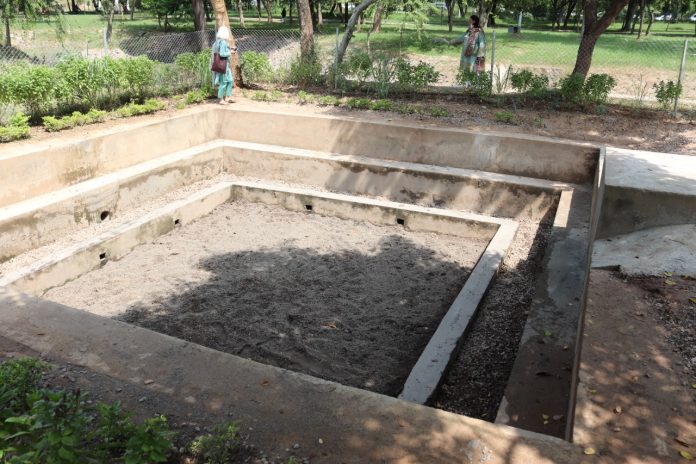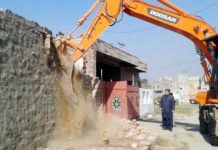Staff Report
ISLAMABAD: Pakistan’s recent climate-induced flooding has given the world a wakeup call to come up with certain solutions to simultaneously tackle drought and urban flooding to avoid human catastrophes in the future.
The country’s experts cognizant to the issue have forcefully suggested on Monday to adopt groundwater recharge wells technology as a national policy to counter urban flooding and ensuing drought due to climate change.
The groundwater recharge well was a cost effective nature based solution to revive aquifer and mitigate the risk of urban flooding through most modern indigenous technology available.
The Institute of Urbanism, International Water Management Institute (IWMI), and Pakistan Council for Research on Water Resources (PCRWR) and Heinrich-Böll-Stiftung (HBS) organized media fellowship on Harvesting Rainwater for Urban Flood Management.
Chairman PCRWR Dr Muhammad Ashraf told that the groundwater recharge solutions were the need of the entire country. Especially in the prevailing floods that occurred in an unprecedented fashion in Pakistan, he added.
Dr Ashraf said Pakistan was facing environmental degradation as in one season it had dryness and in other there were floods.
The rainwater storage solutions like artificial lakes at housing societies or artificial recharge wells would help manage rainwater, he said, adding, “60% agriculture use water is coming from groundwater resources. We will have to either reduce groundwater extraction or increase water table recharge”.
Dr Ashraf elaborated that watershed management was imperative for flood and drought management whereas catchment area enhancement was also crucial for this purpose. The artificial recharge wells’ purpose was to intercept rainwater near catchment area and inject it into groundwater well. “It will help save water from evaporation, ponding and pollution.”
He informed that the Capital Development Authority (CDA) was establishing 100 recharge wells and 20 monitoring stations from its own resources in the federal capital which showed the intention and motivation of the civic body after successful implementation of the pilot projects.
“Out of which 50 recharge wells have conserved 10 million gallons water which at first replenished the groundwater and then reduced Nullah Lai flooding. If the same 10 million gallons of water was dumped into Nullah Lai then it would have resulted in urban flooding and inundation of roads,” he underlined.
To a question, he noted that every recharge well was different from each other as its technology was totally opposite of a pumping well.
He informed that the PCRWR’s focus was on dry land areas as since past seven decades the country’s concentration was laid on arid areas and infrastructure management.
“Today’s floods are due to this neglect of the dryland and rain fed areas as it is a torrential rain flood this time.”
PCRWR, he said had established a network of rainwater harvesting system in Cholistan desert where 110 rainwater harvesting reservoirs were established each with a capacity of four million gallons. The total population of Cholistan region was one hundred thousand and it had livestock population of two million which was their major source of livelihood. In contrast, he said
Thar had 1.5 million population with an overwhelming population of six million and in these areas causalities of livestock rise after water depletion.
Karachi, he said had two major catchment areas of Hub and Malir Rivers that was feasible for efficient rainwater harvesting at all levels with construction of surface storage like small dams, ponds and lakes.
He suggested that the groundwater recharge well should be integral part of building by-laws of public buildings including academic institutions, private housing societies and industries and proposed that the recharging wells could also be established at green belts.
“PCRWR has written letters to 43 housing societies in twin cities of Rawalpindi and Islamabad whereas only two of them responded to adopt rainwater harvesting recharge well technology.” He informed that a recharging well would cost Rs 50,000 to 150,000 where the cost varies as per its size.
Country Director Regional Representative for Central Asia IWMI Dr Mohsin Hafeez told APP that the IPCC Report highlighted heatwave rise and heavy precipitation in South Asia Region due to human induced activities where both the natural phenomenon occurred this year.
The water recharge level in the federal capital was 130-150 millimeters (mm) in 1990 that remained the same in 2021 but the urbanization spiked up rapidly.
“The pilot recharging well help improve 4.5 mm water table at Kachnar Park artificial recharge well whereas IWMI is helping CDA in implementing it on 100 sites.”
When contacted Deputy Director General Water Management CDA, Sardar Khan Zimri, he said the Authority was working out to amend building bylaws to introduce groundwater recharge wells adoption as the water shortage solution at household level.
“We have proposed the higher authority to adopt it at the grassroots or nascent level at community or household level for propitious results. In case, one cannot install it at home then it can be done on the nearby greenbelts.”
However, the administration of schools and education institutions were being assisted by CDA to install groundwater wells due to scarcity of funds, he added.




